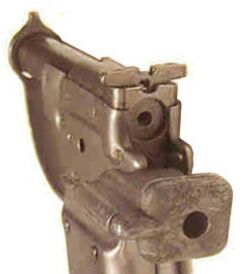In 1942 the United States Office of Strategic Services (OSS) asked the Guide Lamp division of General Motors, Detroit, to design a cheap, simple handgun which could be produced in large numbers.
Although General Motors knew little about firearms, it knew a great deal about the mass-production of small metal items using the most modern methods. Within about three months it had produced about one million of the crude pistols. 300 workers produced a pistol with 23 parts every 7 seconds, 24 hours a day, 7 days a week. This is the only pistol that could be made faster than it could be loaded, which took about 10 seconds. The production cost was $2.10 each.
small metal items using the most modern methods. Within about three months it had produced about one million of the crude pistols. 300 workers produced a pistol with 23 parts every 7 seconds, 24 hours a day, 7 days a week. This is the only pistol that could be made faster than it could be loaded, which took about 10 seconds. The production cost was $2.10 each.
Often referred to as the 'Woolworth Gun', the Liberator Pistol's actual name was the 'Flare Projector' Caliber .45 (FP-45). A single-shot pistol, the Liberator was designed to be scattered about World War II occupied Europe to be used by Resistance groups as disposable assassination weapons or to enable resisters to kill a German soldier and then take his weapon.
The pistol was packed in a paraffin-coated cardboard box with ten rounds of .45 ACP ammunition that could subsequently be stored in the gun's butt, accessable through a sliding trap at the base. Also included was a wooden stick for extracting the spent case and a sheet of comic-strip type operating instructions, using no words. The package was air-dropped where required.
 To load the pistol it was necessary first to pull back the cocking piece and turn it 90 degrees counter-clockwise. The breech was covered by a vertically sliding shutter with a hole for the striker, and was opened by pulling upwards on the backsight. When this was done, a .45 ACP cartridge was inserted, the shutter was pushed down, and the cocking piece was returned to its original position. The pistol was now ready to fire. There was, of course, no safety catch, although a pin on the upper part of the cocking piece passed through a hole in the backsight, presumably to ensure that the shutter did not open and foul the striker. Once a shot had been fired, the entire loading process had to be repeated.
To load the pistol it was necessary first to pull back the cocking piece and turn it 90 degrees counter-clockwise. The breech was covered by a vertically sliding shutter with a hole for the striker, and was opened by pulling upwards on the backsight. When this was done, a .45 ACP cartridge was inserted, the shutter was pushed down, and the cocking piece was returned to its original position. The pistol was now ready to fire. There was, of course, no safety catch, although a pin on the upper part of the cocking piece passed through a hole in the backsight, presumably to ensure that the shutter did not open and foul the striker. Once a shot had been fired, the entire loading process had to be repeated.
Blue Book lists the Liberator's value in the US at $450 to $1000 depending upon condition.